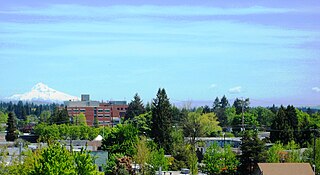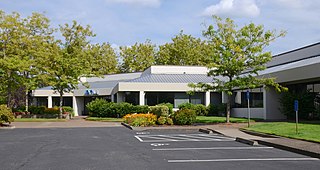
Hillsboro is a city in the U.S. state of Oregon and is the county seat of Washington County. Situated in the Tualatin Valley on the west side of the Portland metropolitan area, the city hosts many high-technology companies, such as Intel, locally known as the Silicon Forest. The population was 106,447 at the 2020 census, making Hillsboro the 5th most populous city in Oregon.

Silicon Forest is a nickname for the Washington County cluster of high-tech companies located in the Portland metropolitan area in the U.S. state of Oregon, and most frequently refers to the industrial corridor between Beaverton and Hillsboro in northwest Oregon.
Lattice Semiconductor Corporation is an American semiconductor company specializing in the design and manufacturing of low power field-programmable gate arrays (FPGAs). Headquartered in the Silicon Forest area of Hillsboro, Oregon, the company also has operations in San Jose, Calif., Shanghai, Manila, Penang, and Singapore. Lattice Semiconductor has more than 1000 employees and an annual revenue of more than $660 million as of 2022. The company was founded in 1983 and went public in 1989. It is traded on the Nasdaq stock exchange under the symbol LSCC.

Reser's Fine Foods, Inc., an American corporation based in Beaverton, Oregon, manufactures and distributes fresh and refrigerated prepared foods. Over 1,000 products are available in the 50 U.S. states, Canada, Guam, Mexico, and areas of the Far East. Its prepared foods are sold in national grocery chains, independent outlets, and convenience stores. Oregon State University's football stadium, Reser Stadium, is named after the company, which is one of its sponsors. Reser’s is also a primary sponsor of Martin Truex Jr. and the #19 Toyota Camry in the NASCAR Cup Series. The company recalled 19 salad products distributed in 29 states in 2016 for possible listeria contamination. Reser's consistently ranks in the top ten privately held Oregon companies by annual revenue.

Hillsboro Airport, also known as Portland–Hillsboro Airport, is a corporate, general aviation and flight-training airport serving the city of Hillsboro, in Washington County, Oregon, United States. It is one of three airports in the Portland, Oregon, metropolitan area owned and operated by the Port of Portland. Established in 1928, it is Oregon's second busiest airport at over 200,000 operations annually. HIO covers 900 acres and has three runways.
Radisys Corporation is an American technology company located in Hillsboro, Oregon, United States that makes technology used by telecommunications companies in mobile networks. Founded in 1987 in Oregon by former employees of Intel, the company went public in 1995. The company's products are used in mobile network applications such as small cell radio access networks, wireless core network elements, deep packet inspection and policy management equipment; conferencing, and media services including voice, video and data. In 2015, the first-quarter revenues of Radisys totaled $48.7 million, and approximately employed 700 people. Arun Bhikshesvaran is the company's chief executive officer.
Teufel Nursery is a family-owned landscaping company based in Hillsboro, Oregon, United States. Founded in 1890, the company maintains existing and installs new landscaping for commercial, government, and residential customers. The company has about 200 employees. It was based in Portland until the 1940s, then in the unincorporated Cedar Mill area until 2007. Its headquarters have been in eastern Hillsboro since fall 2011.

G.I. Joe's was a privately owned retail chain for sporting goods, ready-to-wear clothing, and auto parts; that operated stores in the Pacific Northwest region of the northwestern United States.

Merix Corporation was an American printed circuit board (PCB) manufacturer based in Beaverton, Oregon. Prior to a merger in 2010 with Viasystems, the company had been the 31st largest public company in Oregon based on market capitalization as of 2006. The company is now part of TTM Technologies.

UTC Power was a fuel cell company based in South Windsor, Connecticut. It was part of United Technologies Corporation; it was purchased by ClearEdge Power in February 2013. The company specialized in fuel cells for buildings, buses and automobiles. It has also developed fuel cells for space and submarine applications in the past.

TriQuint Semiconductor was a semiconductor company that designed, manufactured, and supplied high-performance RF modules, components and foundry services. The company was founded in 1985 in Beaverton, Oregon before moving to neighboring Hillsboro, Oregon. In February 2014, Greensboro, North Carolina-based RF Micro Devices and TriQuint announced a merger in which the new company would be Qorvo, Inc., with the merger completed on January 1, 2015.

Phoseon Technology is a privately owned electronic manufacturing company based in Hillsboro in the U.S. state of Oregon. Founded in 2002, the company makes products that use ultraviolet light produced by light emitting diodes (LED) that are used for curing products in industrial settings. Phoseon is located in the Portland metropolitan area and has offices in Europe and Asia. Bill Cortelyou is the chief executive officer and president of the firm.
Cascade Microtech is a semiconductor test equipment manufacturer based in Beaverton in the Portland metropolitan area of the United States. Founded in 1983, the Oregon-based company employs nearly 400 people. Formerly publicly traded company as CSCD on the NASDAQ, the company is now fully merged with FormFactor, Inc.

The PureCell System is a stationary phosphoric acid fuel cell designed, manufactured and marketed by Doosan Fuel Cell America of South Windsor, Connecticut. Designed for distributed generation and micro combined heat and power applications, it is intended for industrial buildings such as hotels, hospitals, data centers, supermarkets, and educational institutions. PureCell System says that its users will see lower energy costs, reduced emissions, 95% system efficiency, 10-year cell stack durability and 20-year product life.

Enli Health Intelligence was a privately held software company based in Beaverton, Oregon, and previously in Hillsboro, Oregon. Founded in 2001 as Kryptiq Corporation, the company specialized in electronic medical records and secure communications between physicians and patients. The 125-employee company was purchased by Surescripts in 2012, which was a previous investor in the company. Annual revenues at the time of the sale were approximately $25 million. In January 2015, the company announced that it was splitting from Surescripts and becoming independent again. Later in 2015, it was renamed Enli Health Intelligence. In 2021, it was acquired by Cedar Gate Technologies, which discontinued use of the Enli name.

Omega Morgan is a privately held company headquartered in Hillsboro in the U.S. state of Oregon. Founded in 1991, the 350-employee company specializes in heavy lifting, specialized transportation, machinery moving, crane and rigging services, plant relocations, equipment installations, millwrighting, and applied and industrial metrology.

Hillsboro Fire & Rescue is the municipal fire department for the city of Hillsboro in the U.S. state of Oregon. Founded in 1880, the department operates five stations with six companies. The department has 123 members and is led by Chief David Downey.
Pensole Footwear Design Academy is a footwear design school based in Portland, Oregon. Founded in 2010 by D’Wayne Edwards, the school has partnerships with institutions such as Parsons The New School for Design, Art Center College of Design, and Massachusetts Institute of Technology, as well as brands such as Foot Locker, Asics, and Adidas. Founder Edwards is a former design director of Brand Jordan, a subsidiary of Oregon based Nike. The school has also worked with Adidas, whose North American headquarters are in Portland, and also hold a design competition called the Future of Footwear.
Hoffman Construction Company is a privately held construction company founded in 1922 based in Portland, Oregon, United States.

Oregon Venture Fund makes venture investments in the Portland, Oregon area and throughout Oregon and SW Washington. The fund consists of 180 institutional and angel investors, of whom 85% have run or founded a business. The fund evaluates up to 300 business plans per year, selecting five to seven to invest in annually. In 2018, the fund changed its name from Oregon Angel Fund to Oregon Venture Fund and launched a new $30M fund. Since its inception, Oregon Venture Fund has generated an average annual rate of return of 34% and a return on investment exceeding $3.50 for each dollar invested.













